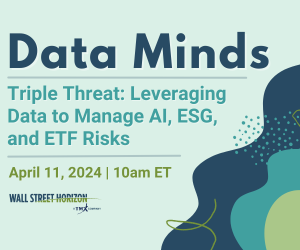Alternative data can take on different meanings to investors so let’s start with a general definition: “alt” data refers to non-traditional or unique information not previously known or available to financial markets.
Essentially, alt data is specialized research, or a new way of conducting research. For example, in the “old days”, hedge funds would send interns to count the number of people walking through a storefront or monitor how many lights were on in a hotel to determine vacancy rates. This information would then be incorporated into an investor’s decision-making process as subtle, underreported signals that weren't being monitored by other market participants.
The alt data of today is, however, much more sophisticated, often leveraging visual images, artificial intelligence and more to find signals and beat the market.
While the explosion of data can be beneficial to traders, raw data alone is of no use unless sense is made of it. Diving deeper into this topic, in March we hosted a joint conference with partner, Lucena Research to discuss broader alt data trends.
Below are a few key highlights.
"Finding Tradable Signals in Alt Data" Panel: Key Takeaways
Interested in learning more?
Watch the full panel discussion and lively Q&A here, which featured the following speakers:
Learn how to find short only signals with event data from Wall Street Horizon and Lucena’s AI platform.
Essentially, alt data is specialized research, or a new way of conducting research. For example, in the “old days”, hedge funds would send interns to count the number of people walking through a storefront or monitor how many lights were on in a hotel to determine vacancy rates. This information would then be incorporated into an investor’s decision-making process as subtle, underreported signals that weren't being monitored by other market participants.
The alt data of today is, however, much more sophisticated, often leveraging visual images, artificial intelligence and more to find signals and beat the market.
While the explosion of data can be beneficial to traders, raw data alone is of no use unless sense is made of it. Diving deeper into this topic, in March we hosted a joint conference with partner, Lucena Research to discuss broader alt data trends.
Below are a few key highlights.
"Finding Tradable Signals in Alt Data" Panel: Key Takeaways
- Deploying human brain power. A key theme discussed during the panel was the significance of using context when applying alternative data to investing strategies. Data should be used in conjunction with the experience and intuition of a human manager, especially when considering a long-term strategy. A smart investor can use the data to augment his or her decision-making process, understanding the intuitive value in the data and then structuring an investment and research process around a thesis. For example, a fund manager can have a computer run a model looking at five investing strategies and spit out returns of each for a certain type of strategy. The “human” (aka fund manager) can then pick out those that are most interesting and build from there, using this “assisted learning” to understand why alpha existed in the first place. Once selected, it’s up to the fund manager to adjust factors such as trading frequency and duration, and even reverse-engineer that for future bets on shorts or hedges.
- Extending data’s shelf life. The panelists also discussed how to most effectively extend the life of data. As Erez Katz, CEO of Lucena noted, no data model can drive alpha forever, and eventually any signal has the potential to become overcrowded and turn into such common knowledge that it’s effectively obsolete. The way to expand the life of data is to layer it with other information. One example would be to use data to create several multi-factor models that may be based on “weak”, uncorrelated models that individually provide a slight advantage. The fund manager can then measure the best-performing, uncorrelated models to determine if a signal can be detected and give more credence to the better-performing models. An approach like this can extend the life of data, and models can also be “re-trained” over time to prevent portfolios from suffering alpha decay.
- Turning Data into Information. Ultimately, as our own CEO Barry Star said during the event, having access to data is simply not enough. The data needs to be cleaned and transformed to become information. As useful information, it can then be manipulated even further to become knowledge or learnings. As learnings, it finally can be turned into alpha when traders incorporate it into their investing strategies. The facts show that signals still exist and that data – when manipulated and parsed properly – can be used to glean knowledge and give firms an edge in this highly competitive landscape.
Interested in learning more?
Watch the full panel discussion and lively Q&A here, which featured the following speakers:
- Rich Carbone, VP Data Strategy, Jefferies LLC (moderator)
- Olga Kokareva, Head of Data Sourcing and Strategy, Quantstellation
- Erez Katz, CEO and Co-Founder, Lucena Research
- Barry L. Star, CEO and Founder, Wall Street Horizon
- Jeff Ferro, Portfolio Manager, Quantitative Strategies
Learn how to find short only signals with event data from Wall Street Horizon and Lucena’s AI platform.
_thumb.png)
_thumb.png)
_thumb.png)
_thumb.png)





_thumb.png)




